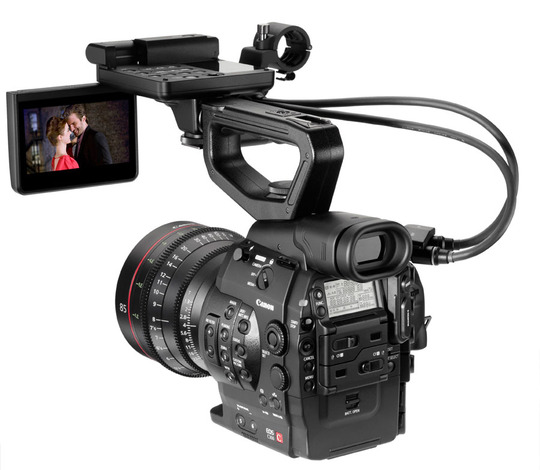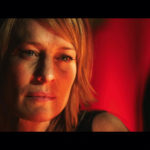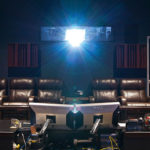
Canon’s Hollywood Ambitions
Posted on Dec 30, 2011 by Alex Fice
November the 3rd was a double whammy day of product releases, JULIAN MITCHELL got caught up in the excitement
 Martin Scorsese gave the Canon event a Hollywood seal of approval if not his own recommendationIt was a hot and sunny November day in Los Angeles as we waited outside of a Paramount Studios theatre for what we guessed was going to be a historic announcement ostensibly about a new camera from Canon. But as I looked about at the scenery and the embedded movie props – the bench from Forrest Gump, the wall from The Truman Show – at the pockets of drama, there was a throng of Japanese Canon executives following cinematographer (and perhaps more importantly producer of the film Reverie) Vincent LaForet around at a respectful distance, taking pictures of him. It struck me that this gathering of the Canon clans had much more significance that a mere product launch. Among the more excitable journalists there was talk of the announcement being the purchase by Canon of Paramount Studios. The fact that Canon had been in profit for years, that RED had bought the old Ren-Mar studios just three blocks down and ‘remember that Sony bought Columbia!’. That was the eighties when there was more money about and Paramount don’t need to sell, they are just about to beat Warner Bros to be the highest grossing studio in town. Just for a second though we all got excited, or more excited.
Martin Scorsese gave the Canon event a Hollywood seal of approval if not his own recommendationIt was a hot and sunny November day in Los Angeles as we waited outside of a Paramount Studios theatre for what we guessed was going to be a historic announcement ostensibly about a new camera from Canon. But as I looked about at the scenery and the embedded movie props – the bench from Forrest Gump, the wall from The Truman Show – at the pockets of drama, there was a throng of Japanese Canon executives following cinematographer (and perhaps more importantly producer of the film Reverie) Vincent LaForet around at a respectful distance, taking pictures of him. It struck me that this gathering of the Canon clans had much more significance that a mere product launch. Among the more excitable journalists there was talk of the announcement being the purchase by Canon of Paramount Studios. The fact that Canon had been in profit for years, that RED had bought the old Ren-Mar studios just three blocks down and ‘remember that Sony bought Columbia!’. That was the eighties when there was more money about and Paramount don’t need to sell, they are just about to beat Warner Bros to be the highest grossing studio in town. Just for a second though we all got excited, or more excited.
There was no doubt though this was the biggest product launch I have seen for over ten years, the previous ‘biggy’ was Thomson’s Infinity camera, a product that was ahead of its time and so perhaps a victim of a too eager release date. Canon’s launch was a statement of intent to the content making capital of the world and all the other players in content creation, we even planned to do some live blogging when we got inside, it had that kind of significance.
Once inside the theatre things proceeded with more familiarity but also with some special guests. Canon’s CEO and Chairman of the Board (also the nephew of the founder of the company) Fujio Mitarai had made the trip, apparently he rarely ventures out of Japan. Mr Mitarai emphasised that since the company was founded in 1937 they had strived to produce the best products in the world including the Canon 5D Mk2. “That camera is related to why we are here today, he teased – now we have Cinema EOS!”. The camera took centre stage but then if you read between the lines you could hear Mr Mitarai talking directly to the Hollywood community and asking for acceptance in to the film and television production industry.
Cue Martin Scorsese another speaker at the event. Was he to open the door for them? Not directly, he cleverly meandered through a history of the cinema without pinning his allegiances to Canon’s ambitions. He did however finish his speech with ‘Welcome to Hollywood’, Whether that was a stating of the obvious as we sat in Paramount Studios or a congratulatory acknowledgment of becoming a player here, we will never know.
Another speaker from Canon Japan, Masaya Maeda, was the man who originally pushed for the video function on the EOS 5D MkII, “I was certain that video on this camera would bring a great new business opportunity.” He couldn’t believe how right he was and soon Canon had sent their chief designer in charge of the EOS video function to Hollywood on a fact finding mission. The reaction to the 5D MkII was so good that plans were hatched for a camera that was designed from the ground up for video. That camera was to be the C300.
First Generation Camera
The new camera is Canon’s first generation system, Canon are here for the long haul and in many conversations said as much; ‘The next camera’ or ‘This is only the start’. The constant here is access to their range of EF mount lenses, apparently there are more than 70 million of them out there from a range of nearly 70 to choose from. The five new EF digital cinema lenses takes that total over 70. It was only last year that Canon were at a loss how to market cinema lenses to the film community and this summer they released the FK14.5-60 and 30-300 wide angle and cine zoom lenses to the market. These are now part of the new lens range launched along with the C300, along with PL mount versions of the same lenses.
The serious business of designing this new camera starting about three years ago and most of the impetus to drive it forward came from the US arm of the company, Larry Thorpe of Canon USA explained the first steps: “It was born and raised among us in the USA. They spent a lot of time interviewing DPs and Directors saying if we were to take the lead from a 5D MkII to a proper motion imaging camera what would you like us to do? Most of them said that they loved the compact size of the 5D and that lovely handheld feel that you have with it. If you can protect that and build in modularity so we can build it up in to a fully rigged camera with larger lenses, we would use it. The majority said that.
“We brought the design team over to meet a number of the key people that we had identified. The designers listened and then brought over a mock-up back about a year ago and showed it to a whole bunch of people. In the meantime the sensor was being developed separately. There was a massive effort in the last year to finalise the ergonomics of the design.
“It was really the first time that the marketing people at Canon had more or less written the complete spec with the help of the end users and said to ‘Canon Japan Inc’ this is what we’d like you to build. They were able to reach in to the EOS side and video side and bring talent from both. These departments were very silo’d before and it was down to Mr Maeda who heads up the technology platform and he said: ‘Our time has come, you have to do it and pull together whoever you need to get it done.”
Our guess is that Japan were quite happy to make the camera as long as there was an immediate business to sell in to. That would explain taking the processor from the popular broadcast camera the XF305 with the same workflow and cheap media. Coupling that with a super 35mm sized new sensor which would delight broadcasters and interest movie makers even with a codec and workflow that could be termed as old. The street price will be about EURO12-13000 but it’s up to the dealers to decide on the final amount. There are already discounts out there.
The Images
Canon EOS C300 = Awesome from Jonathan Yi on Vimeo.
Canon gave prototypes of the camera to various DPs and Directors. Some of the results made it to Canon’s web sites and some didn’t. One that didn’t was from film maker Jonathan Yi (above)whose film satirised the whole ‘camera test on YouTube’ genre film but with some expert analysis of the C300. For Canon he went too far but ironically it’s the most entertaining and complimentary films of the lot.
Canon were very hands-off on the films, they saw the scripts but had no censorship of the content unless obviously detrimental. Richard Crudo was the Director and DP of Max Is Back one of the films shown at the Paramount Studios event: “You could go through the technical stats all day long, people tend to get caught up in those things. For me ultimately it’s the end product, what does it look like. I thought the look was extremely filmic and for my application almost effortless to achieve.”
Director and DP Sam Nicholson was instrumental in getting Canon to update the original 5D MkII to 24p and shot one of the event films called XXIT (pronounced EXIT): “I really appreciated the size and flexibility of the camera. With this camera you find yourself carrying it around in one hand, you can work faster with it and it fills a slot in creative story telling that no other camera does.
XXIT – Demo from Stargate Studios on Vimeo.
“Its 16,000 ISO is the same as other camera’s 1600. The great thing about the EF model is that if you’re out on location and need another lens you can just visit a local photographic shop and pick up what you need. Same for the media.”
The film makers were also impressed with battery life on such a small battery. “It runs for ever.” Said Félix Alcalá the Director of Sword another film shot on the C300. Vincent LaForet who shot the film Mobius with the cameras commented that it was nice to shoot with something akin to the 5D MkII without all the workarounds he has to put up with for the last three years.”
Richard Crudo commented on the low light capability of the camera: “We shot at night on Pico Boulevard completely with available light. We shot with the 300mm new cinema zoom wide open and what we got out of it was absolutely astonishing. I was continually blown away at the amount of detail in the dark areas. The camera was able to hold the highlights as well.”
Sam Nicholson on the same subject: “I think our whole lighting kit consisted of two white panels and an iPad. If you need to go to 20,000 ISO you can. We shot green screen at 16,000 which is crazy! It sees beyond what you can see with the human eye which I think is really cool, and it’s beautiful at the same time.”
A question from the floor was to do with rolling shutter and none of the film makers had any trouble with it. The same went for Jonathan Yi who threw the camera around a lot. The other directors did the same with swish pans and mountings on motorbikes. Larry Thorpe said that it isn’t zero but it’s much improved through the new sensor’s technology.
Revolutionary Times?
The best information you can get about this camera at the moment is from the people who have used it. There are some interesting points including the one about permits for shooting. In New York at the moment if you don’t put a camera on a tripod you don’t need a permit, it’s the same thing in other capitals like Rome. The C300 encourages hand held shooting.
The cinematographers we talked to think this camera or this style of camera will illicit a lot of change and remarked that there will be a fight about that change. Sam Nicholson again: “For my whole life it’s about overcoming barriers to wanting to make your ideas in to movies particularly in VFX. This camera is fantastically portable.”
The cost savings to be had when using this small camera was also a big subject. Location shooting becomes more cost effective as you don’t need so many vans, as many bodies lifting the heavy gear. To that you can add the post route without the need for transcoding or de-bayering. Also having two cards gives you instant back-up if you need it but you can also run them into each other.
There was also talk of the camera’s low light capability bringing different styles of shooting that didn’t depend on using heavy lights. Sam Nicholson talked about a certain fakeness that lights give you but now with this camera you got a different type of ‘truth’.
For me the images at the theatre event were fine but at the Canon Expo on one of the Paramount sound stages the pictures looked much better and easily as good as anything I had seen before – (apart from Sony’s F65 demo at IBC).
Listening to Sam Nicholson when he described how they pulled key on his heavy green screen movie XXIT was perhaps the acid test. Remember the specs say that the C300 is an 8-bit output camera but Sam was pulling keys perfectly in difficult situations like flaring where the image can sometimes fall apart and can contaminate the green.










